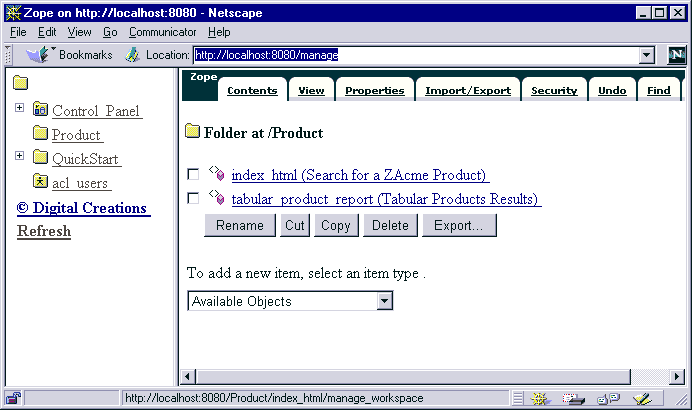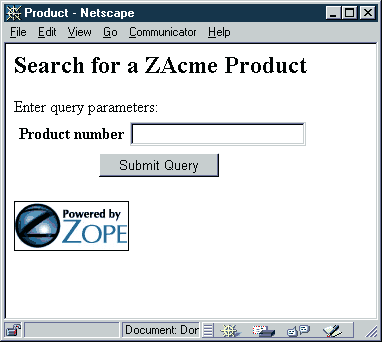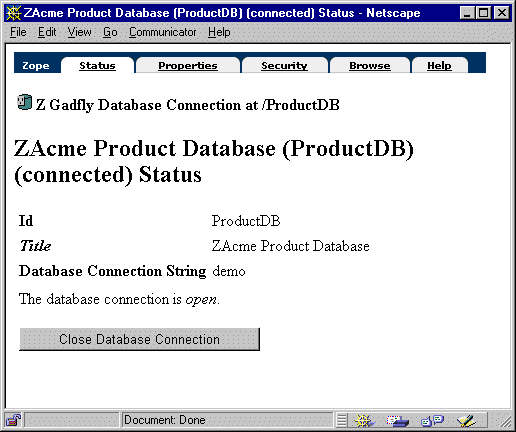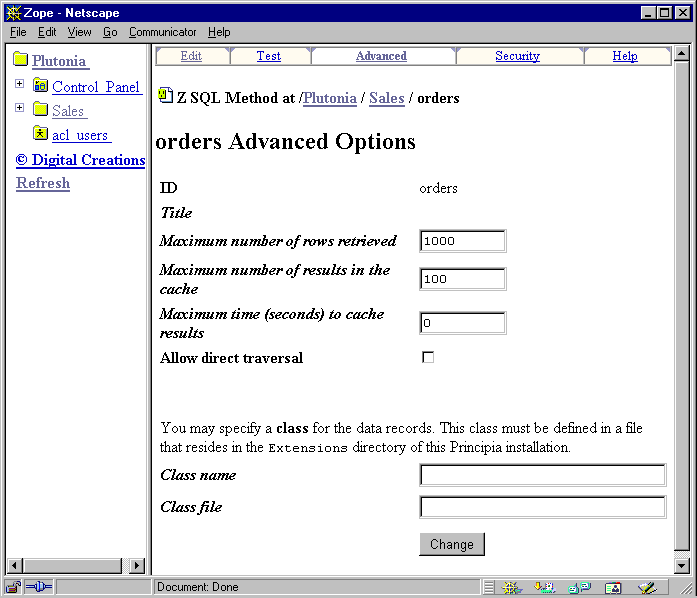Z SQL Methods User's Guide


Document Revision 2.1.0, February 4, 2000
Modified by Pam Crosby
For Zope version 2.1.1
Table of Contents
Establish a database connection 3
Object-Relational Data Integration 18
The relational data object model 18
Creating Database Connections 21
Creating SQL database methods 25
Testing and debugging SQL database-methods 27
Editing SQL database methods 29
Advanced SQL database method configuration 30
Database Method
Document Template Markup Language Tags 32
Inserting values with the sqlvar tag 32
Inserting equality comparisons with sqltest 33
Inserting optional tests with sqlgroup 34
Introduction
Z SQL Methods provide access to relational and external databases from Zope . Zope applications are built on object oriented databases. All Zope data are stored in this object database. Database queries and commands can be used to publish relational data, collect and store data in relational databases, and create complex web-deployed database applications.
Z SQL Methods provide high performance by maintaining open database connections, so it is not necessary to connect to a database on each request.
Z SQL Methods utilize features of Zope , to enable complex applications that would be harder to create in other environments.
Purpose of The Z SQL Methods User's Guide
This guide was created to provide an overview of the attributes of ZSQL Methods, Zope Structured Query Language. The format of the guide provides step by step instructions on how to publish relational data on the Web. With Zope examples and explanations, the user create SQL queries using DTML.
- The Zope object database can be queried like relational databases using DTML commands.
- You can query existing relational databases within Zope to provide web based content management.
- Relational database queries results are first-class Zope objects.
- The Z SQL methods supports the integration of relational data with the Zope object system.
- Database Connections explain how to manage and create connections to external databases.
- Instructions to create search interfaces between Zope and database queries are explored.
This guide will take you through creating, testing and debugging, query templates, and editing of SQL database methods. SQL Methods supports a number of specialized tags for inserting values or comparisons into SQL source, an explanation of these various tags are provided in this guide.
Getting Started
Publishing relational data on the Web with ZSQL Methods typically requires three steps:
Establish a database connection
A database connection can provide several things; an abstraction of a database - relational or external and an interface to a relational or other external database.
To create a database connection:
- Pick a database to use
- Determine identifying information needed by the database,
- Decide where in Zope the connection will be used, and
- Add a database connection to the desired Zope Folder .
For example, ZAcme, Inc. has a parts database that they wish to make available for searching. They have a Gadfly1 database that they wish to access within the Product area site. The ZAcme Product manager, Stan, adds a Z Gadfly Database Connection . The form is displayed in Figure 1 where Stan can enter the id , title , and select a data source for the database connection.
Create a database method
The database method provides the mechanism for executing database queries and other commands. It also makes the results available to Zope .
Stan starts with a small products database consisting of the two styles of widgets ZAcme creates and the database, ProductDB using the connection. Stan need to place some values into the database. To accomplish this task, Stan will add a SQL Method.
Add a SQL Method by selecting it from the Available Objects menu.
- Name the SQL Method id sqlCreateTables .
- The Connection Id will have the ProductDB highlighted.
- In the Arguments field, enter add product_number, product_description, product_price and ship_weight.
- In the Query template, make the product_number and product_description string type. The product_price and ship_weigh t are float type. Figure 2 shows the SQL Method after adding the method.

|
The SQL used to perform the query is specified as a query template . Query templates use the same Document Template Markup Language ( DTML ) used to create Zope's DTML Documents and DTML Methods . Query templates provide specialized tags for use in generating SQL.
Stan had created a product table and tested the method by pressing Add and Test. The screen shows that this method is not a query and the table creation code is returned. If there had been an error, a message would be printed on the top of the screen as shown in Figure 3.
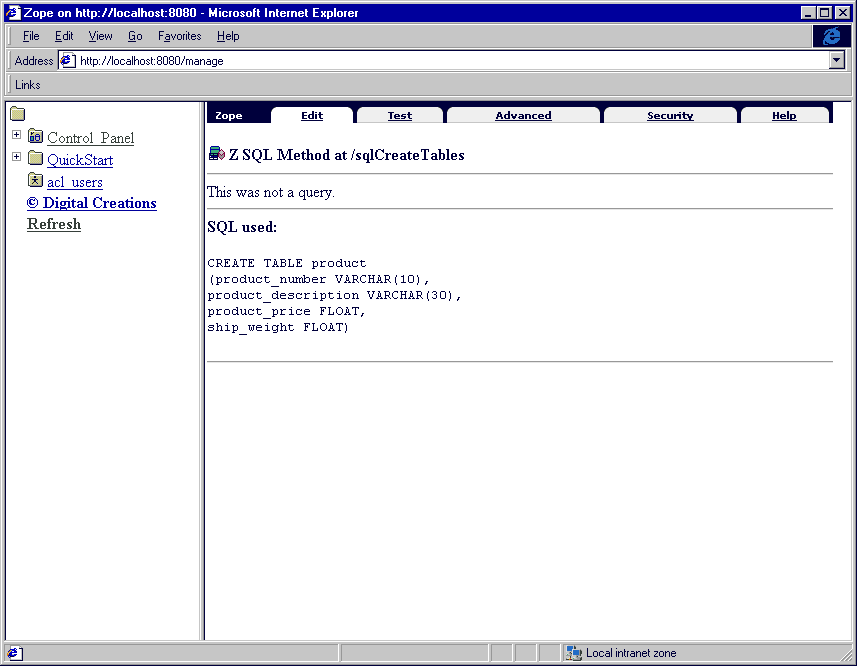
|
Data Entry
The next step is to create a data entry method for the table. Stan creates another SQL Method to insert products into the product table.
- Enter sqlInsertProduct into the id field.
- Add Insert Products for the Title.
- In the Arguments field add product_number ship_weight product_price product_description.
- The Query template area add the SQL code shown in Figure 4.
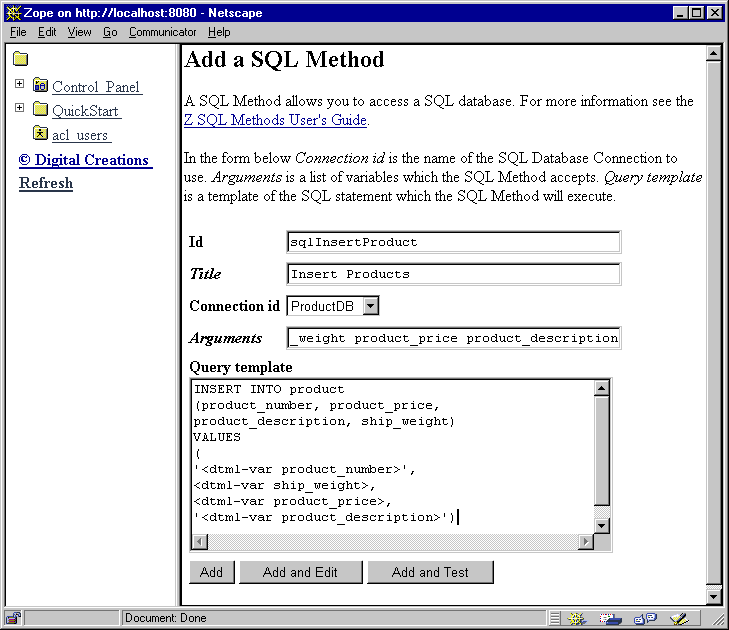
|
After entering the information, Stan selects Add and Test to check for errors. The test view of the SQL method gives the fields with a form for entering the data. Stan enters information about the Historical Widgets and submits his query. .

|
Data Verification
The next step in this procedure is to verify the values entered in the database. When Stan submits the query, the screen shows the SQL used and the entered data, Figure 6. Stan enters the Millenium Widgets and Products Manual data in the same way using the sqlInsertProduct method.

|
Data Retreival
To retrieve data from the products database, Stan will have to create an query.
An dtml-sqltest tag is used to insert an SQL test that compares the column, product_number to a value given as input in the argument product_number . Stan adds another SQL Method named lookup_product.
- Enter the lookup_product into the id field.
- Add Lookup a product given a product number for the title.
- The argument field only needs the product_number.
- The Query template has the sqltest to allow comparisons. (Figure 7)

|
Stan adds and tests the SQL method by pressing the Add and Test option. An input form is displayed, as shown in Figure 8. Product number widget is added to the form and submitted.

|
When the query is submitted, the output is displayed along with the SQL that was generated as shown in figure See Test Output.
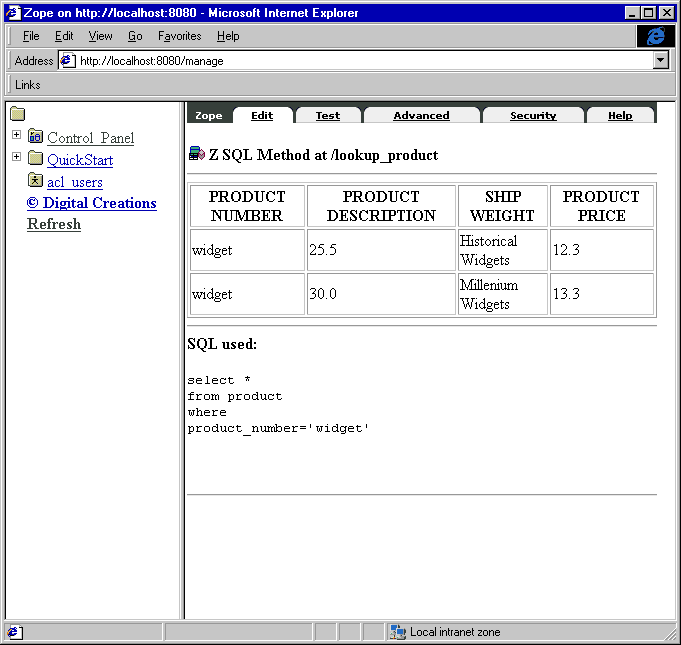
|
After a database method has been created, it must be tested to:
- Make sure that the SQL statement performs the desired query or action, and
- To allow Zope to collect information about results needed for building a search interface.
A database method can be tested when it is created by clicking on the "Add and Test" button on the add form or any any time by selecting the test view. After a database method has been created and tested, a search interface can be created to publish the data on the web. This leads to exploring Search Interfaces in the next section.
Creating Search Interfaces
Database methods provide an interface between Zope and database queries. To publish data on the Web, Zope DTML Documents must be created if necessary, to collect input data, and to display reports. Input forms and reports can be created from scratch, but is easier to use the Z Search Interface Creation Wizard to automatically create search interfaces. The search interface wizard collects basic information, such as the name of a database method and names of input and report documents to be created and then writes new documents based on database schema information. After the documents have been created with the search interface wizard, they can be customized.
Figure 10 shows the Search Interface Creation Wizard being used to create a search interface for the lookup_product database method. The first option in the form is a list of searchable objects found in the current folder, or in folders above the current folder. Searchable objects are objects, like ZSQL Database Methods , that support searching for information2. You can select one or more searchable objects to be included in the search interface. If you select multiple searchable objects, the generated input form will collect information needed for all objects, and the generated report will show results for each object, in sequence.
Figure See Contents view of the Products folder after adding a tabular search interface. shows the contents of the Product folder after the New Search Interface has been submitted. The contents list includes two new documents, index_html, and tabular_product_report . By naming the input form index_html , we have created a "home page" for the Product area that performs a product search. For example, if someone visited the URL http://zacme.com/ZAcme/Product, they would see the search input form shown in Figure 12.
The source of the generated input form is shown screen capture in figure See Index_html view. The input form is a Zope DTML Method object.
There are a number of features of the input form that should be noted:
- DTML var and if tags are used to construct a "Cancel" button if the HTTP Referer header is supplied in the request. The DTML Method view shows the DTML script created with the Search interface.
- Stan wants to add the CANCEL button. He modifys the script.
- By adding the following lines after <tr><td colspan=2 align=center>
< input type="SUBMIT" name="SUBMIT" value="Cancel">
<INPUT NAME="CANCEL_ACTION" TYPE="HIDDEN"
VALUE="<dtml-var HTTP_REFERER>">
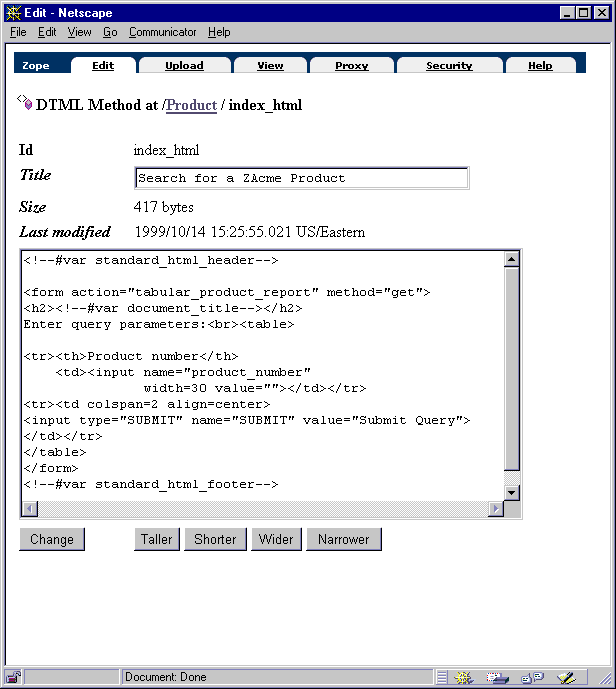
|
- The variables standard_html_header and standard_html_footer are used to provide standard look-and-feel components in the form.
- For example, we might want to define a logo for the ZAcme Products division to be included at the top of all documents. We add a Zope Image object, named logo , to the Product folder, and we add a Zope DTML Document named standard_html_header that includes a reference to the logo (Figure 14). Inserting an Image object with a dtml-var tag causes an HTML IMG tag to be inserted referring to the image and including an ALT attribute with the title defined for the Image object. After these changes, the input form is displayed as shown in Figure 15.
When Stan submits the input form, the form has the ZAcme Logo across the top. Figure 16 shows a the output of the tabular_product_report .
The source of tabular_product_report is shown in figures See Part one of the source of the tabular_product_report document that was generated by the search-interface creation wizard. -See Part three of the tabular_product_report document, showing source to display following batches and text to be inserted when there are no results.. It is useful to walk through the generated document template source. The generated source illustrates a number important document template concepts and features of database methods. The section "Interactive Insertion, the dtml-in Tag" in the Document Template Markup Language Reference provides a detailed description of document template dtml- in tags, including batch processing.
The source begins with the insertion of standard_html_header , as usual. An dtml-in tag follows the insertion of the standard header. The dtml-in tag is used to iterate over the results of the call method, lookup_product . The database method receives its parameters from the incoming HTTP request, so parameters need not be passed explicitly3. The dtml- in tag uses the size and start attributes to request batch processing support4. This causes a number of special variables to be defined, which are used later in the dtml- in tag source. These include previous-sequence , sequence-query , previous-sequence-start-number and previous-sequence-size .
Immediately after the dtml-
in
tag is a
dtml-if
tag that inserts text when the variable
sequence-start
is true, or, in other words, when displaying the first item in a batch of items. The inserted text includes a link to previous batches of data and a table header showing the data column names. The link to previous batches is inserted only if there are previous batches, as indicated by the
previous-batches
variable. The link uses the dtml-
in
tag variables
sequence-query
,
previous-sequence-start-number
, and
previous-sequence-size
.
After the table header is inserted, the actual data for each item in the batch is inserted (figure See Part two of the tabular_product_report Document, showing the DTML text to insert data items.).
The last part of the text following the dtml- in tag is text to insert a table closing tag and to show a link to additional batches of data, if any (Figure 19). Two dtml- if tags are used to insert the text only when displaying the last item in a batch and to only include the link to following batches. Finally, the source ends with an dtml- else tag that inserts text if there are no results for the given inputs.
After the search-interface creation wizard has been used to create report and input-form documents, the documents can be edited to meet specific needs.
Object-Relational Data Integration
ZSQL Methods support the integration of relational data with the Zope object system. Results of relational database queries are not just data. Rather, results of relational database queries are objects, which may have methods and can acquire information and behavior from the Zope environment. ZSQL Methods that use SQL select statements provide virtual collections of objects and can support direct object addressing through URLs.
The relational data object model
Data from relational database queries are returned as sequences of Python objects. Because each query result is a sequence, the dtml-in tag and the Python for statement may be used to iterate over results. Each element in a result sequence is a Python object that encapsulates a single record of a result table. The Python objects that encapsulates result records are called record objects.
Record objects provide access to result data by column name. Result columns are available as both attributes and as mapping keys of record objects. This allows columns to be accessed with simple dtml-var tags inside dtml-in tags when iterating over query results. For example, consider a Z SQL Method named customers that returns columns CUSTOMER_ID, NAME, and PLANET. From DTML, the customer names can be accessed with:
<dtml-in customers>
<dtml-var NAME>
</dtml-in>
and from Python, the customer names can be accessed with:
for customer in customers():
print customer.NAME
or
for customer in customers():
print customer['NAME']
Column data can also be accessed using integer column numbers. Each record object is a sequence of column values. For example, the data for a record can be output without use of column names in DTML:
<table>
<dtml-in customers>
<tr>
<dtml-in sequence-item>
<td><dtml-var sequence-item></td>
</dtml-in>
</tr>
</dtml-in>
</table>
for customer in customers():
for data in customer:
print data
Defining result classes
The Advanced view on database methods provides the ability to supply Python classes from which result objects can inherit methods. This facility allows rich behavior to be provided using the Python programming language. Individual database results are instances of subclasses and have data attributes from the relational database.
In the future, it will be possible to define ZClasses to provide behavior to database results.
Acquiring Data and Behavior
Database results can acquire data and methods from their environment. Methods, such as DTML Documents, External Methods and other SQL Methods that are defined in the folder containing an SQL method can be applied directly to objects returned from SQL queries.
Object Access
There are two ways to access objects through ZSQL Methods. Objects can be accessed by iterating over the results of calling a ZSQL Methods as demostrated in the chapter before. The second way is to direcly access object through URL.
For database methods that return individual records, objects may be accessed directly through URL traversal. Consider the lookup_part query in figure 8. This method takes a single argument, a product number, and returns the corresponding part. A URL can be used to access a specific part by adding the input argument name, product_number and a specific product name to the URL for the database method. For example, to look up product number widget , a URL like:
http://zacme.com/ZAcme/Product/lookup_part/product_number/widget
might be used. Normally, record objects don't provide a default interface, so it will be necessary to invoke a method of the object, as in:
http://zacme.com/ZAcme/Product/lookup_part/product_number/widget/orders
This example uses the method orders on a product number. The orders method was not created in previous section. This method could be defined in a class specified in the ZSQL Method Advanced view, or it could be a method that is acquired from the Zope environment. In the Advanced view, select the allow transversal option for the URL access to funnction properly. See Advanced Options for SQL Method shows the transveral option as well as the place for the class definition. More information is available in the SQL Database Methods chapter.
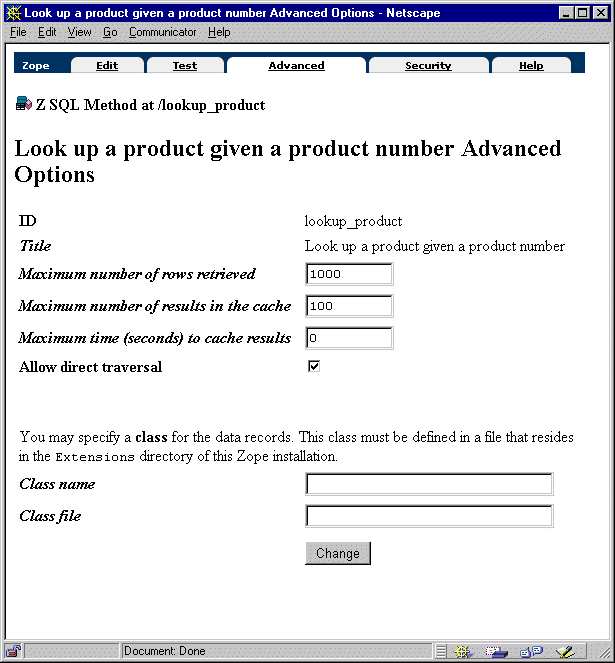
|
 Database Connections
Database Connections
Overview
Database Connections are used to establish and manage connections to external databases, such as relational databases. Database Connections must be established before database methods can be defined. Moreover, every Z SQL Method must be associated with a Database Connection.
Database Connections provide management interfaces for connecting to and disconnecting from the external database. Some database connections provide interfaces for browsing database schema information. Database connections are provided in Zope database adapter products. Database adapters are available for a number of databases, including ODBC, Solid, Oracle, MySQL and Gadfly.
The information needed to connect to a database depends on the specific database being used. Some database adapters provide database connection creation interfaces that let you select from a known set of databases, while others require you to enter a connection string.
Database connections are established when a database connection is created and later whenever a database connection is used. Database connections are automatically closed after a period of disuse and reopened when necessary.
Creating Database Connections
To create a database connection, display the Contents view of a Folder , and select " Z Gadfly Database Connection " from the available object list. The database connection add form will be displayed See Add Connections Form. Enter the id , title , and information identifying the database, such as a data source name or connection string. Normally, a connection to the database is established immediately, To delay connecting to the database until later, select the Connect immediately check box.
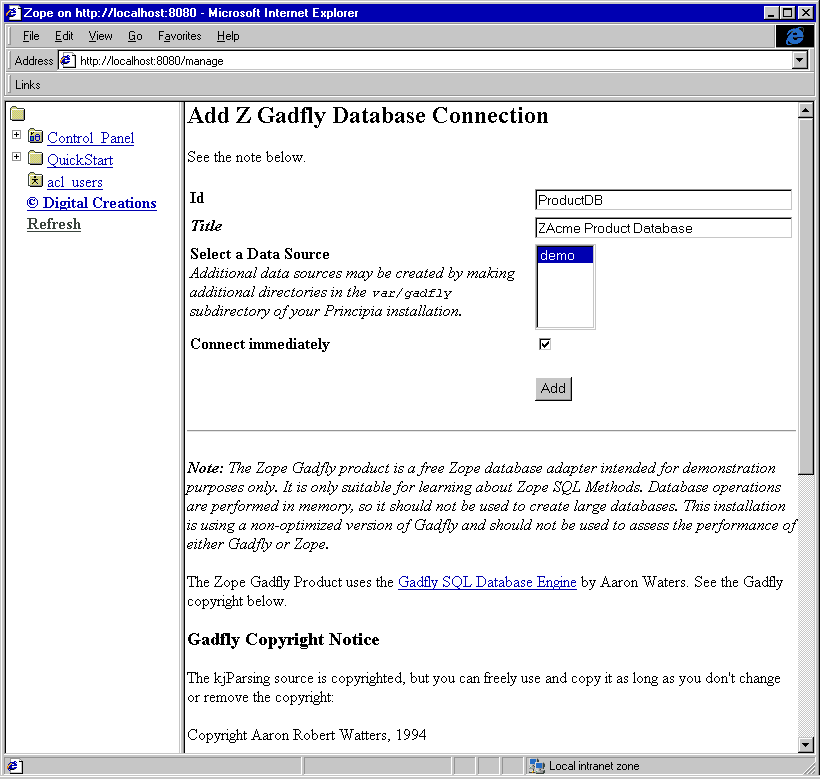
|
Connection Status
The Status view shows whether the database connection is open or not, and provides a button to open the connection if it is closed, or to close it if it is open (See A database-connection status view).
Connection Properties
The Properties view (See Database-connection properties view) provides a place to change the database connection title and other database-specific connection information.
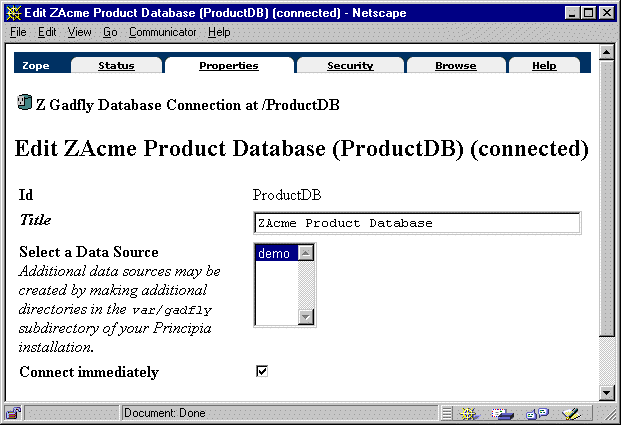
|
Connection Browse
Some databases provide a Browse view for browsing the tables defined in a database. Database tables are listed and individual table listings may be expanded to show table schemas as shown in See Database Connection Browse.
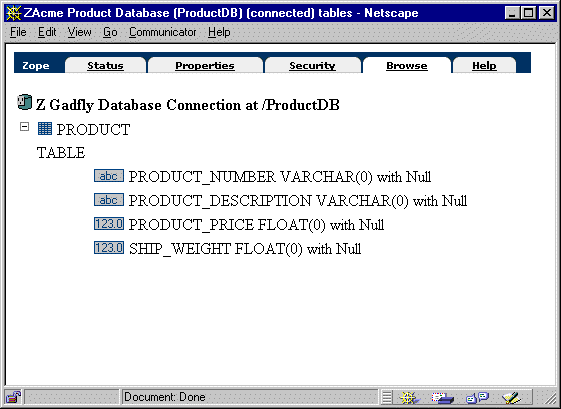
|
Connection Security
As with all objects in Zope, you can specify security options for the database connection. These options can be given to individual user or groups. The options available are shown in See Database Connection Security.
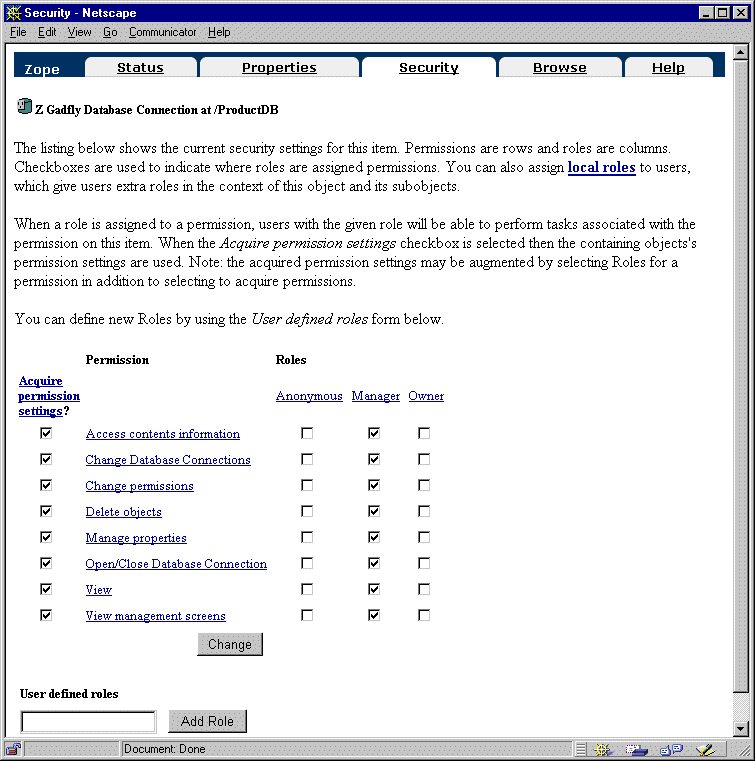
|
 SQL Database Methods
SQL Database Methods
Overview
Z SQL Database Methods provide a means for treating SQL database programs as objects that can be used to publish database data and create advanced Zope applications .
Separation of database management and presentation management is accomplished through database methods and documents. Unlike many other Zope objects, such as DTML Methods and Images , database methods are not meant to be accessed directly through the Web. Rather, they are used by other Zope objects, such as DTML Documents to obtain data to be displayed. SQL Database Methods are used to manage SQL, and DTML Methods are used to manage presentation.
Creating SQL database methods
An SQL Database Method is created by selecting " Z SQL Database Method " in the add list of a Folder Contents view, after which an input form is presented. In addition to the standard Zope properties, id and title , three additional properties may be specified.
The required property, connection id is used to specify which database connection will be used by the database method. A Database Connection object must be created prior to creating an SQL Database Method . The database connection can be created in the current folder, or in any folder above the current folder. The connection list shown in the input form shows all connections that can be found in the current folder or in folders above the current folder.
The optional property, arguments , is used to specify one or more input arguments. Input arguments are used to customize a query based input data, such as data passed in a Web request, or in a DTML expr attribute. Arguments not specified in this list will not be acquired from the REQUEST environment (e.g., form variables). Multiple arguments are separated by one or more spaces or tab characters. Each argument is specified as an argument name, an optional argument type, and an optional argument default. The argument name should consist of letters, underscores, and digits and should start with a letter.
The type should be one of the values shown in See Database-method input argument types. The default type is string .
|
A date-time value. A wide variety of formats are accepted5. Year, months, and day can be provided in any unambiguous order6. Month names and abbreviations of various forms may be provided. Hours, minutes and seconds are optional and are separated from the date by one or more spaces and from each other by colons. A 24-hour clock is assumed unless times are followed by am, AM, pm or PM. |
|
|
A list of values. This is useful to insure that a sequence of values is available when the query template uses an dtml-in tag to iterate over inputs. The list type may be combined with the int , float , and date types to specify a list of integers, floating-point numbers, and dates. |
|
|
A single input string is split on line endings into a list of one or more values. |
|
|
A single input string is split on sequences of one or more space, tab, new-line, or carriage-return characters into a list of values. |
|
|
A single input string in which sequences of new-line and carriage-return characters are converted to single newline characters. |
See Some sample database-method input arguments shows several examples of input arguments.
The query template is the source of the desired SQL query or commands in DTML format. DTML tags may be used to substitute text into a query based on input data and on information defined in Zope .
Testing and debugging SQL database-methods
After an SQL Database Method has been created, it should be tested to make sure that the query template is correct and to generate search interfaces. To test an SQL Database Method , select its icon in the contents view of the containing Folder . Selecting the Test tab causes an input form to be displayed, as shown in See Insert Values Form from sqlInsertProduct. Selecting the " Submit Query " button causes the database method to be executed and the results to be displayed in a table . The SQL used is also shown. If the results are not what was expected, the SQL may be inspected to see if the expected substitutions were performed.
If an error occurs, an error message is displayed as shown in See Test output showing an error message and SQL used..
Query templates
Query templates are used to generate SQL statements based on Web request input data and other Zope data. Consider the following example of a query template:
SELECT * FROM product
WHERE product_number = <dtml-sqlvar product_number type=string>
The intention is to dynamically create a query using data that either comes in with the HTTP REQUEST or is otherwise available to the SQL Database Method object (e.g., acquired data, folder property data, etc.). In this example, an sqlvar tag was used to insert a value into an sql statement.
Consider an HTML form that contains the following INPUT tag:
<INPUT NAME="product_number" TYPE="text" SIZE="6">
If the user entered the value widget into the product_number input box then the query template shown above would be evaluated to:
SELECT * FROM product WHERE product_number = 'widget'
An ordinary dtml- var tag could be used as well, however, the sql_quote var tag attribute should be used to make sure that SQL quote characters are handled correctly. The dtml- var tag would be useful if special dtml-var tag features like the lower attribute were needed:
SELECT * FROM parts
WHERE part_no = <dtml-var part_number sql_quote lower>
Because query templates are themselves document templates you have access to all of the DTML constructs. This includes all of the looping, conditional and iterative commands. Consider the following query template:
SELECT * FROM sales where part_no in
(
<dtml-in list_promotional_items>
<dtml-unless sequence-start>,</dtml-unless>
'<dtml-var promo_item_part_number fmt=sql-quote>'
</dtml-in list_promotional_items>
)
This SQL Database Method would executes another SQL Database Method called list_promotional_items and, for every row in the result, insert a case in the SQL dtml- in list. In this example, the variable promo_item_part_number is in the results of the list_promotional_items query.
The query templates can get their variables from either the HTTP request or from any variables available in the Folder containing the SQL Database Method object. It is often useful to develop SQL Database Methods with this lookup order/variable resolution in mind. The following rules control the order in which variable lookup is performed, depending on whether or not the variable name in question is in the arguments property of the SQL Database Method .
|
Variables in the folder containing the SQL Database Method . |
||
It is often necessary to execute more than one SQL statement in a single SQL Database Method. SQL Database Methods define a variable, sql_delimiter , that can be used to divide individual SQL statements. Consider the following two SQL statements which debit a user's checking account and credit a loan account by the same amount:
UPDATE checking_account_balances WHERE
<dtml-sqltest customer_number column=customer_no type=string>
SET balance = balance - <dtml-sqlvar loan_payment type=float>
<dtml-var sql_delimiter>
UPDATE loan_account_balances WHERE
<dtml-var customer_number column=customer_no type=string>
SET balance = balance + <dtml-sqlvar loan_payment type=float>
Note that no more than one SQL select statement may be used in a single SQL Database Method .
Editing SQL database methods
Editing database methods is done using the database method Edit view. In addition to the standard Zope property, title , the connection id , arguments , and query template can be changed.
It is recommended that you test a database method after editing it, using the Test view.
Advanced SQL database method configuration
The Advanced view (See SQL Database Method Advanced view) provides access to advanced configuration properties of SQL Database Methods .
- Maximum number of rows retrieved
- Maximum number of results in the cache
- Maximum time (seconds) to cache results
- Allow direct traversal
You can also designate a class for the data records retrieved by the SQL Database Method . In order to use this advanced feature you need to define both a class name and a class file name. The class file must be stored in the Extensions directory of the Zope installation. A sample class is detailed in the See Database Method Classes section.
Maximum Number of Rows Retrieved
The maximum number of rows retrieved can be limited by setting this value. This value cannot be blank. This parameter limits the number of rows returned from the underlying database to the SQL Database Method object.
Caching results
For performance reasons, it is possible to cache the results of queries. Caching is controlled by the properties: maximum number of results in the cache and maximum time (seconds) to cache results . The property, maximum number of results in the cache , limits how large the cache can grow. The property, maximum time (seconds) to cache results , sets the maximum age of cached results. Setting either of these to zero disables caching. the key for entries in this cache is the rendered SQL statement that generated the result.
Direct Traversal
Database methods that return a single record requested with a primary key can be traversed with a URL to access a record object directly. Normally, argument names must be included in the URL. If the database method has a single argument, then the allow direct traversal is displayed in the Advanced view. If argument values are known to not conflict with database method names, then, the allow direct traversal option should be enabled and the argument name need not be included in the URL.
Database Method Classes
It is possible to assign a class to the records returned by a Database Method. This class is a Python7 class defined in a Python file located in the Extensions directory 8 of the Zope installation being considered.
Classes can be used to augment otherwise static records returned from a database query with more interesting behavior. For example consider the following class definition (in a file called hardware.py located in the Extensions directory of the current Zope installation):
class ComputerHardwareItem:
def dollar_volume_backordered(self):
return self.unit_price * self.backordered
By virtue of assigning the ComputerHardwareItem class to this Database Method we now have access to the dollar_volume_backordered function for each record returned by the query. We can now refer to the dollar_volume_backordered DTML variable inside an iteration over query results.
Database Method
Document Template Markup Language Tags
Overview
SQL Methods support a number of specialized tags for inserting values or comparisons into SQL source. These tags provide a number of advantages:
- SQL Templates are simpler and clearer,
- Values are type-checked to make sure that the data are at least syntactically valid,
- Single quotes in string values are appropriately quoted,
- When doing comparisons in selections, multiple input values can be automatically rendered using the SQL in test.
- When doing comparisons in selections, inputs may be optional.
Inserting values with the sqlvar tag
The sqlvar tag is used to type-safely insert values into SQL text. The sqlvar tag is similar to the dtml-var tag, except that it replaces text formatting parameters with SQL type information.
The attributes used by the sqlvar tag are shown in See Attributes of the sqlvar tag.
<dtml-sqlvar x type=nb optional>
Let's do it
'Let''s do it'
however, if x is omitted or an empty string, then the value inserted is null.
Inserting equality comparisons with sqltest
The sqltest tag is used to test whether an SQL column is equal to a value given in a DTML variable. .
<dtml-sqltest color column=color_name type=nb multiple>
If the value of the color variable is "red", then the following test is inserted:
column_name = 'red'
If a list of values is given, such as: "red", "pink", and "purple", then an SQL in test is inserted:
column_name = in (red, pink, purple)
The optional parameter ' op ' support the following operations:
eq renders to '=' ne renders to '<>'
gt renders to '>' ge renders to '>=' also gte
lt renders to '<' le renders to '<=' also lte
So because of this, you can render:
<dtml-sqltest foo op=gt type=string>
foo > 'bar'
One note is that if 'op' doesn't match the options listed above, it will render whatever is provided, so:
<dtml-sqltest foo op=like type=string>
foo like 'bar'
Inserting optional tests with sqlgroup
It is sometimes useful to make inputs to an SQL statement optional. Doing so can be difficult, because not only must the test be inserted conditionally, but SQL boolean operators may or may not be needed depending on whether other, possibly optional, comparisons have been done. The sqlgroup tag automates the conditional insertion of boolean operators.
The sqlgroup tag is a block tag. It can have any number of and and or continuation tags. The attributes of the sqlgroup tag are shown in See Attributes of the sqlgroup tag.
The sqlgroup tag checks to see if text to be inserted contains other than whitespace characters. If it does, then it is inserted with the appropriate boolean operator, as indicated by use of an ' and' or 'or' tag, otherwise, no text is inserted.
Suppose we want to find people with a given first or nick name, city and minimum and maximum age. Suppose we want all inputs to be optional, but want to require some input. We can use DTML source like the following:
select * from people
<dtml-sqlgroup required where>
<dtml-sqlgroup>
<dtml-sqltest name column=nick_name type=nb multiple optional>
<dtml-or>
<dtml-sqltest name column=first_name type=nb multiple optional>
</dtml-sqlgroup>
<dtml-and>
<dtml-sqltest home_town type=nb optional>
<dtml-and>
<dtml-if minimum_age>
age >= <dtml-sqlvar minimum_age type=int>
</dtml-if>
<dtml-and>
<dtml-if maximum_age>
age <= <dtml-sqlvar maximum_age type=int>
</dtml-if>
</dtml-sqlgroup>
If we evaluated this template with values set for home town and name, we would get an SQL query like the following:
select * from people where
((nick_name='Jim'
or first_name='Jim'
)
and home_town='Cleveland'
)
This example illustrates how groups can be nested to control boolean evaluation order. It also illustrates that the grouping facility can also be used with other DTML tags like dtml- if tags.

